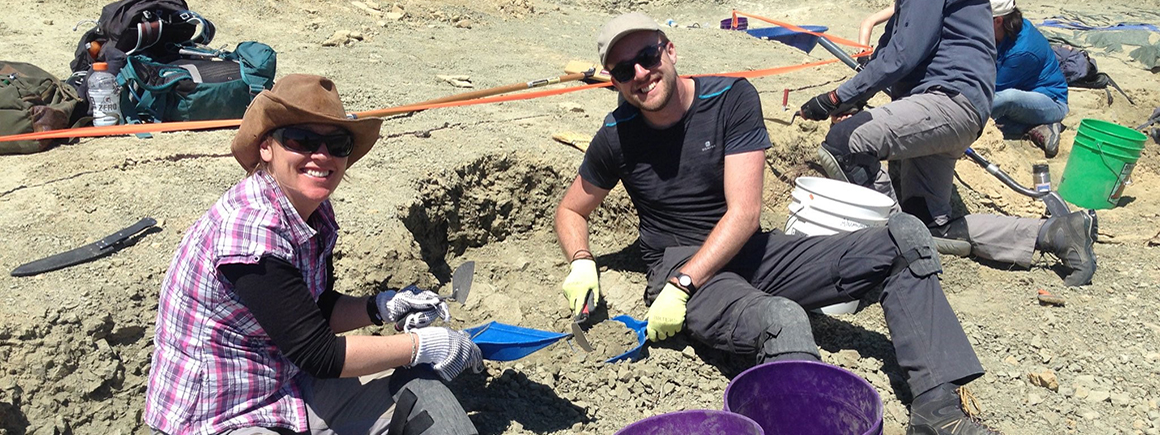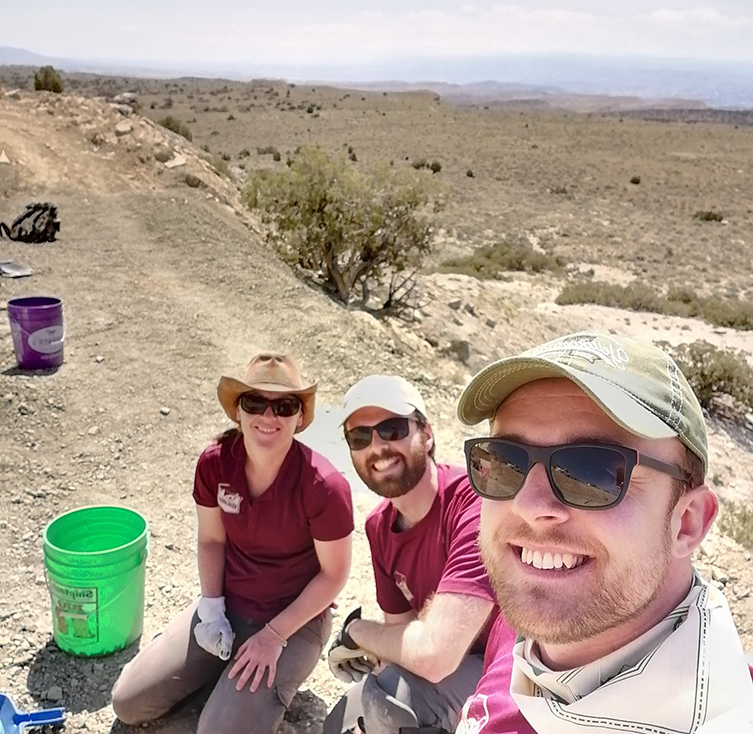Can biofuels solve the planetary emergency we are facing?
Masters student Sophie Jane Tudge details her research into biofuels.

Dr Susannah Maidment and postgraduate student Joe Bonsor on a fossil dig
Laura Hemmingham (1st year PhD student) and Joe Bonsor (3rd year PhD student) talk about their experience of studying at the Museum.
Laura: I look at the diets of deer in the Pleistocene, so at the moment I’m studying the fossil deer collections using a process called dental microwear analysis.
Joe: I mainly work in the collections; we have thousands of dinosaur fossils and most of my time in the Museum involves me analysing and studying these specimens.

Laura in the lab looking at fossil teeth
Laura: Yes, there are drawers of thousands of fossils that I’m allowed to look through and choose what to study. It’s like looking through a jewellery box filled with tiny treasures. I’m also travelling to other institutes to use collections elsewhere too.
Joe: My work is very much collections based, we have so many specimens in the Museum and I’m lucky enough to be able to work on some of them. I’m trying to find out how British dinosaurs linked to the famous Iguanodon are all related to one another. I look at the shapes of bones to find common features and use software to plot these into a sort of dinosaur family tree.
Laura: There’s such a wide range of research topics that happen under the Museum's roof - including ancient DNA andplanetary and microbiological studies that span billions of years of Earth’s history. It’s really nice that we are all united by our passion for understanding more about planet Earth.
Joe: A huge variety of research, I was surprised just how much when I first started. From ecology, insects, mammals, and dinosaurs to fish and everything in between, involving hundreds of researchers across the Museum.

Joe and Dr Susie Maidment on a fossil dig
Laura: I’m still quite early on in my PhD so I haven’t yet, but I’m really looking forward to getting involved in various museum events.
Joe: I’ve done a few public evening events showcasing my research where I had a stall showing fossils and techniques I use, and I’ve done a few talks on fieldwork and some of our key specimens. During the past year, I’ve also taken part in several online events and spoken to schools which were a lot of fun.
Laura: When I look through the Pleistocene mammal collections I often come across specimens that I’m not studying but are really cool to look at - from woolly rhino and woolly mammoth teeth to hyaena coprolites (fossilised poo!) from tens of thousands of years ago. There are also fossil collections that Darwin himself collected on his travels.
Joe: I do get the chance to look through some of the non-dinosaur palaeontology collections sometimes, the Pleistocene mammals are also a favourite of mine, particularly the mammoth specimens from London that were discovered when the Museum was being built!
Laura: Yes, I find visiting museums inspiring enough, but when you’re there alone with the displays, it’s a great time to reflect on what motivates you!
Joe: Before and after public opening hours are some of the best times in the museum. You can look around exhibits and experience a side of the museum not many people get the chance to see. It's empty and quiet and very peaceful just to spend some time in your favourite areas.
Laura: On my first day, my supervisor gave me a tour of the Pleistocene collections. The two specimens that stick in my mind were woolly mammoth fur and a full glyptodon shell that was big enough for me to crouch under!
Joe: My favourite specimen is the Archaeopteryx we have in the Treasures gallery. It's the original fossil for this species, the first known bird from around 150 million years ago and is priceless in both its scientific and monetary value.
Laura: I was amazed at how many specimens were in the Natural History Museum stores, millions of them! It’s great because while the larger or more interesting specimens can go in the main displays, the Museum still has such a vast collection which is really important for research.
Joe: The Museum houses over 80 million specimens, and obviously due to space constraints only a tiny proportion of those can go on display at any one time, the collections behind the scenes contain the rest, but visitors can view any of these by appointment.
Laura: I’m part of the London NERC DTP, which is a training partnership that allows students to choose a project with supervisors spread across 8 London institutions. I have a supervisor at both the Natural History Museum and Royal Holloway, University of London.
Joe: I applied for a PhD directly with the University of Bath, and my project is split between there and the Natural History Museum, so I have supervisors at both institutions. My funding comes from the Leverhulme Trust.
Masters student Sophie Jane Tudge details her research into biofuels.